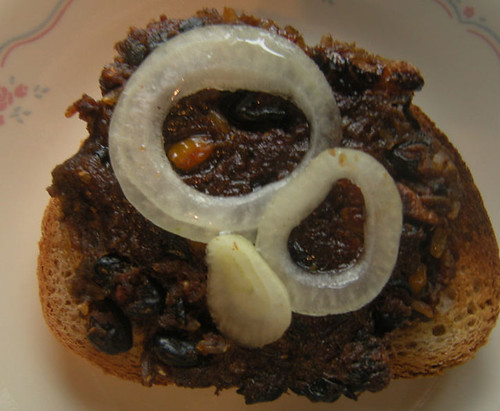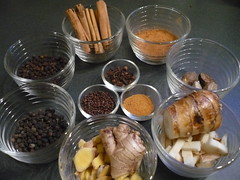
Milwaukee is not a small place. I have occasionally forgotten that, because I grew up in Chicago, which, in all its immensity, easily dwarfs large numbers of the world's cities. I was reminded of the fact that Milwaukee is not all that small when I was hunting for a particular product.
There isn't much cookery going on right now, as mentioned in last post, but that has got to change. I have to eat, and when I saw my food bill this month, I realized that I can't keep this restaurant eating thing up. Sure, I have no time to cook, and yes, it's given me a reason to try a number of restaurants I've been meaning to try, but the plain fact is that I am a social servant in this culture, and so I never have the luxury of spending all the money I might feel like spending.
For a very long time, I have been trying to make a vegan, no-soy-cheese substitute sauce that will stand in for cheese in pre-1601 recipes. The standard vegan substitute in this situation is nutritional yeast, and, while the nootch certainly does impart a flavor that works and is distantly like Parmesan cheese, my blackened Laurel heart will not rest until I can come up with a sauce that will be cheese tasting and comprised of verifiable pre-1601 ingredients. You can make an argument for nootch based on the idea that yeast was certainly used for cookery in period and that it is occasionally written about in a way that you can pretend implies adding it strictly for flavor, but the plain fact, as far as I can tell, is that nootch as a specifically produced food is pretty recent on the "inventions in cookery" timeline.
This is not true of fermented tofu. Somewhere out in the world there are a bazzillion cooks who, when presented with the same challenge, might have said "Oh, yeah, I know just what to do!" and reached for their jar of doufu-ru, but I had to learn it existed. Tofu is not something I ever loved even when I was eating whatever soy jumped on to my plate, so the chances of me stumbling on this stuff became tiny, tiny, tiny the moment I realized I was going to have to cut unfermented soy out of my diet. 99.99% of the tofu on the American market is your garden variety bean curd that, as useful as it is to the general vegan/non-ovolacto piscetarian, is something that anyone with thyroid issues is not going to be able to touch.
Fermented tofu, according to
this article, appears in the written record in China in 1578 CE. And so, having stumbled across the existence of the product thanks to surfing teh internetz, I stumbled around the Milwaukee area trying to find it.
And that brings me round to the point.
I suspected I could find the product in one of the many Asian markets in the area. What I wanted to know was if I could find it elsewhere--the Asian markets most likely to have a wide selection of products tend to be more on the north end of the metro area, and thus, a bit out of my way.
In Outpost? Nope. If it's not at
Outpost, then there is little point in trying the more standard grocers in the area, although I did give my favorite
Sentry a brief run through, just in case. Nope.
However, there is a grocer in the Milwaukee area, a place of legendary status in this metro area, a place that is considered so upscale that a number of my former acquaintances will only shop there because they imagine it adds to their "high-class" cache:
Sendiks. I've only shopped there a few times, never particularly impressed either positively or negatively.
I have an impression now, though.
Sendik's sucks.
It sucks like a suck ass sucking thing of suckiness.
I swear to dog, it has got to be by the good will and generosity of the people of Milwaukee that this local chain continues to thrive--kind of like the same way people kept buying Van Heusen shirts because they were "American made" long after it had become very clear that Van Heusen had shipped its manufacturing overseas. Only a willingness to believe the bluff could explain why anyone thinks this is a chain full of unusual and finer foodstuffs for the tony crowd. That may have been true a long time ago, but it is not true now. Is there a place for Sendiks in the Milwaukee market? Sure. If they are offering a selection of things Joellen Average will never otherwise try at a price that isn't too much for her family to bear, great: I'm all for wider experiences for everyone. And if she gets her little ego boosted, well, as long as she doesn't cross my path, it's all good. But is it the establishment it's reputed to be?
Oh, hell, no. I saw nothing there that I could not find elsewhere--with one exception: the despair-inducing deli section.
Well, let's be fair--I'm not going to like anything with mango in it. I'm especially not going to like it if the "crab" turns out to be that shitty fake crab crap with the allergy-provoking egg ingredients in it. So if your special crab salad has eggs and mangoes in it, I'm going to get sick eating it.
Which I did.
If that was all, I'd shut up. But the cabbage salad sucked. The sushi--not something you'd even begin to expect would be fabulous in a grocery story--was just
sad, and that was just a vegetable roll. What the hell would it have been like if there was seafood in it? I have long understood that too much wasabi ruins the balance of delicate flavors an amuse-bouche of sushi can provide, but
for the first time ever, I was extraordinarily grateful for the wasabi--it changed the awful vegetable roll into a nice crispy crunchy base useful for transporting the fabulous flavor of horseradish into my mouth.
Gak. Sendik's, I am so done with you.
After that trip, I abandoned the immediate vicinity search and went to a north side Asian grocer. Milwaukee's near north side is not the nicer area, but it's not bad. A lot of rural Wisconsinites find it terrifying, and people have left my place of employment after one visit to a home on the north side, too nervous to look past their lack of familiarity with the urban experience and notice that "lack of expensive houses" does not equate with "radically terrifying and vastly dangerous area of horrific poverty."
I found the above jars at Rhino Foods. I popped it open, and, yay! It does taste remarkably like bleu cheese. Yay.
I'll soon be popping some into a non-cheese sauce, hereafter described as a geeze gravy, to determine how it will work as a flavoring agent in a non-dairy béchamel--essentially, what all vegan "cheese" sauces turn out to be. Yes, every vegan food writer talks like he or she has just invented the Best. Vegan. Cheese. Sauce. Evah. whenever they bust out their recipes (hence my thinking of them as "geeze" gravies), but all this tells me is that American cooks really lack in some basic skills. I am eternally grateful to my Junior High School Home Ec teacher for teaching me to make a white sauce. Little did I know at 12 years old that I was being given a key to a cookery kingdom.



 It worked out okay! It'll be easy to mod for a version I can eat, I think. I didn't have tomatoes, so I subbed 12 oz of tomato paste and 36 oz of water, and ground beef for lamb. Since I was making this for Michael, I made the
It worked out okay! It'll be easy to mod for a version I can eat, I think. I didn't have tomatoes, so I subbed 12 oz of tomato paste and 36 oz of water, and ground beef for lamb. Since I was making this for Michael, I made the 





















